Severe Cuts Projected for Herring Fishery
Continued from July 2018 Homepage
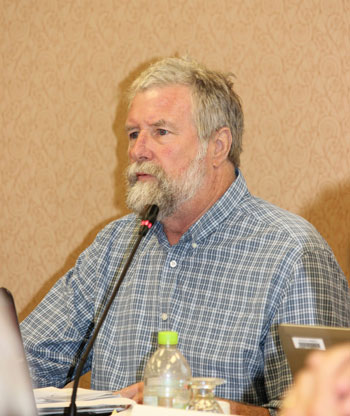
“The near-term future of this fishery looks quite bleak.” Terry Stockwell, former NEFMC Chairman and one of Maine’s two representatives on the council. Fishermen’s Voice photo
NEFMC’s Atlantic Herring Stock Assessment Working Group expressed concern that the population now contains more age 6 fish than age 1 and age 2 fish combined. “If these estimates hold true, then the spawning stock biomass of Atlantic herring is apt to remain relatively low without improved recruitment,” the release says. “The Council recognized that very large quota reductions may be inevitable in the 2019-2021 specifications package given the preliminary assessment results.”
The determination is based on a new stock assessment, still in draft form, that indicates recruitment – incoming year classes of newly born fish – has been poor for several years. Four of the six lowest recruitment years occurred in 2013, 2015, 2016, and 2017.
“This means very few young fish have been added to the resource in recent years,” according to the release. Poor recruitment is expected to result in lower catch limits, the release says.
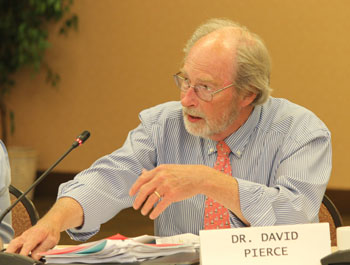
NEFMC member David Pierce noted that four of the lowest recruitment years in the herring stock have occurred since 2013. “I would assume we will continue to get low recruitment, and maybe these numbers that are pessimistic should be even more pessimistic.” Fishermen’s Voice photo
The situation informed public comments on draft Amendment 8 insofar as speakers were concerned about how new restrictions would affect their ability to operate if the quotas were already projected to be slashed.
Amendment 8 contains 10 ABC control rule alternatives. To read the 10 alternatives for the ABC control rule see Draft, #1–Public Hearing Document, Pages 9 & 10 at (nefmc.org/library/amendment-8-2). Alternative 1 would be “no action” and would retain the status quo. The other alternatives have various reductions on fishing when the biomass declines to certain levels. The alternatives don’t specify numbers; instead, each is a formula between fishing and biomass aimed at meeting performance parameters set by NEFMC.
Speakers supporting the status quo spoke to the need for NEFMC to retain flexibility in managing harvest allocations, particularly in light of projected quota reductions.
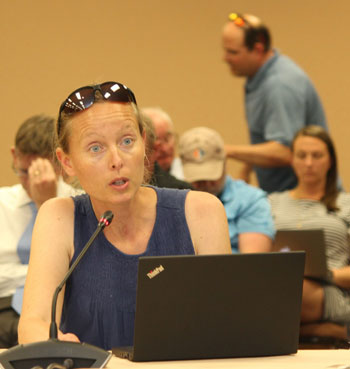
Meghan Lapp, Seafreeze Ltd., North Kingston, RI. Her group supported no action. Fishermen’s Voice photo
Meghan Lapp, fisheries liaison for Seafreeze Ltd. in North Kingston, R.I., said her group supported no action. “We believe it’s important to allow the council flexibility to set the catch for three years with the option for annual adjustments, especially considering the potential outcome of the herring assessments,” she said.
Also supporting the status quo was Jeff Kaelin, representing Lund’s Fisheries Inc., which runs midwater trawl vessels out of Cape May, N.J. “Flexibility is going to be particularly important over at least the next specification cycle, with a new stock assessment reducing quotas over the next three years,” he said. “A three-year specification continues to be a priority for us in terms of being able to plan our business and the allocation of effort to our vessels.”
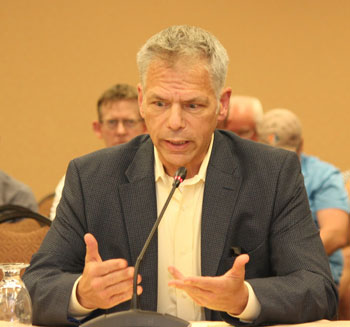
Shaun Gehan, attorney, for the Sustainable Fisheries Coalition, a trade group. “There are a lot of forage fish out there. Fish eat a lot of different fish.” Fishermen’s Voice photo
Shaun Gehan, an attorney representing the Sustainable Fisheries Coalition, a trade group representing herring fishermen and processors, said the issues addressed in Amendment 8 are discretionary. “It’s not like overfishing has been declared and the council must react,” he said. “That’s important because, ultimately, if we decide to do nothing, we’d be fully compliant with the law. But the stock assessment, which people have just started to come to grips with, has sort of overtaken many of the issues. A lot of the ABC control rule alternatives are very determinative – they would take away the flexibility that the council has now to react to situations like they are now.”
With regard to localized depletion: The alternatives, the document says, are intended to address “concerns with concentrated, intense commercial fishing of Atlantic herring in specific areas and at certain times that may cause detrimental socioeconomic impacts on other user groups (commercial, recreational, ecotourism) who depend upon adequate local availability of Atlantic herring to support business and recreational interests both at sea and on shore.”
The localized depletion alternatives are:
Alt 1: No action (no midwater trawl gear in Area 1A (June-September)
Alt 2: 6-nautical-mile closure in Area 114 (June-August) or (June-October)
Alt 3: Extend Area 1A prohibition of midwater trawl gear year-round
Alt 4: 12-nautical-mile prohibition of midwater gear
Alt 5: 25-nautical-mile prohibition of midwater gear
Alt 6: 50-nautical-mile prohibition of midwater gear
Alt 7: Prohibit midwater gear in five 30-minute squares
Alt 8: Revert boundary between Areas 1B/3
Alt 9: Remove seasonal closure of Area 1B
Following regular council business there was a two hour session for public comment. The comments of 11 industry individuals who made comments appear here in the order in which they spoke.
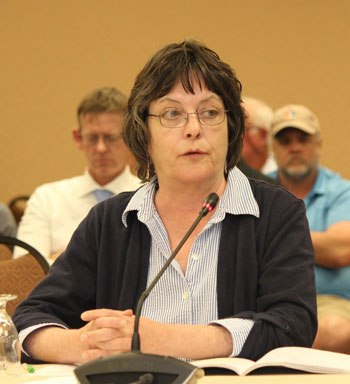
M.B. Tooley, O’Hara Corporation, Rockland, ME. “I don’t think any of the alternatives are at all appropriate.” Fishermen’s Voice photo
Mary Beth Tooley, who coordinates government and regulatory affairs for commercial fishing operations for the O’Hara Corporation in Rockland, said there’s no evidence to support the idea that localized depletion is occurring. “What’s clear is the buffer zones are extremely punitive to the fishery,” she said. “Even the 12-mile buffer represents 20 percent of the midwater trawlers.” Given the quota reductions on the table, “I don’t think any of the alternatives are at all appropriate.”
Kaelin said he supported Alternative 9. “It would lift seasonal restrictions on fishing in Area 1B,” he said. “We think returning to a winter fishery there, and thereby increasing opportunity for both the mackerel fishery and the herring fishery in the winter, will reduce congestion on the water in the spring. In retrospect, changing the access to that area to May, as was done some time ago, was a mistake. Not only did it reduce our access to mackerel, but it put us on the grounds at the same time that everyone else was on the water, and that probably wasn’t a strategically sound decision. We want to go in the wintertime and we think that in itself will reduce a lot of the concern about too many people on the water at the same time.”
The proposed buffer zones, Kaelin continued, would have “serious economic impacts on the herring fishery, even if we weren’t looking at quota reduction in the neighborhood of 50-60 percent. We think they’re punitive in nature. We don’t think there’s any scientific evidence to indicate that there’s been problem with midwater trawl activity anywhere since they came into the fishery in the mid-1990s.”
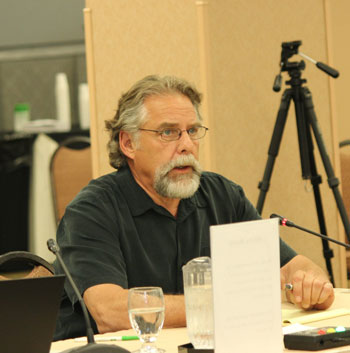
Jeff Kaelin, industry representative of Lund Fisheries of Cape May, NJ. “So we’re status quo all the way.” Fishermen’s Voice photo
Kaelin said midwater trawling has been used worldwide, and most European pelagic midwater trawl fisheries have been certified by the Marine Stewardship Council as sustainable. “Both from a fishery perspective and an environmental perspective, it’s one of the most environmentally benign gear types used around the world to catch pelagic fish,” he said. He added, “This is all about market. This anti-midwater trawl issue was spawned back in the mid-90s, when we started to use midwater trawls in the sardine factories, because they would produce fish day or night. The seiners were getting beat because they had to fish only certain hours of the day…I don’t see any biological reason to impose any buffer zones. The economic costs far outstrip any biological benefit, which are only speculative in nature. New restrictions on fishing in nearshore areas wi
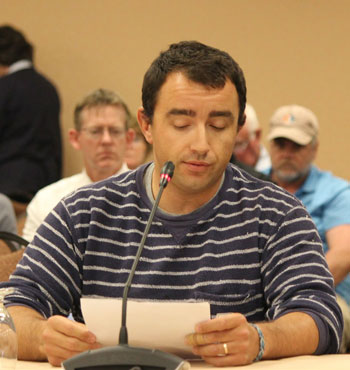
Chris Weiner, tuna fisherman and CHOIR member. “This type of trawling is the biggest threat.” Fishermen’s Voice photo
Kaelin said his group finds there’s no evidence of localized depletion as an issue of biological concern. “There’s no scientific evidence that suggests that herring fishing, particularly at recent conservative levels of operation, going aback 10-plus years, causes any adverse biological impacts relative to human needs or the needs of marine predators,” he said. “So we’re status quo all the way.”
But Chris Weiner of the industry coalition CHOIR said, “This type of trawling is the biggest threat” to the herring resource and the fishery.
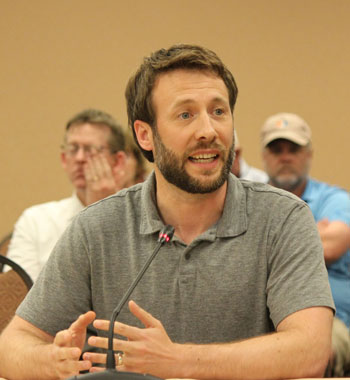
Ben Martens, executive director of the Maine Coast Fishermen’s Association. “The control rule was based on growing biomass. We no longer have growing biomass.” Fishermen’s Voice photo
Ben Martens, executive director of the Maine Coast Fishermen’s Association (MCFA) in Brunswick and one of the founding members of CHOIR, said his group had supported the proposed 12-mile buffer. “But looking at the dramatic stock decline that we’re seeing in the stock assessment, that might not be enough,” he said. “We need to do what we can to make sure there’s a robust herring population. We need to make sure there’s enough bait in the ocean for the lobster fleet and for everyone else that needs it. When we look at the control rule, it was based on growing biomass. We no longer have growing biomass. So we need to put a control rule in place that will help us rebuild. The population has declined significantly. That might not be due to overfishing….But we’ve been taking a lot of herring out of the ocean for a long time and that will have an impact on recruitment.” Martens said it’s important to realize that herring is not just bait: “It’s a forage stock for rebuilding other fisheries.”
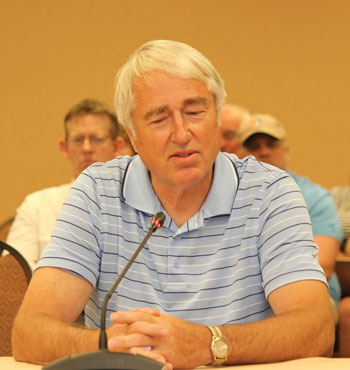
Glenn Robbins, Atlantic herring seiner FV Western Sea. “The only time they really catch fish on Georges is September during spawning season.” Fishermen’s Voice photo
Glenn Robbins of Eliot, who owns a purse seine vessel, said the herring resource on George Bank has been wiped out. “That is localized depletion,” he said. This is the second time in 20 years, he said, that he’s seen it wiped out. “The last time it got wiped out, the inshore fishery didn’t suffer too much. I’m afraid it might now. We have been protecting the inshore fishery with spawning closure. So if we had one on Georges, we might still be able to fish there now. Now, the only time they really catch fish on Georges is September” during spawning season when herring move more slowly, he said. “I’m afraid if we don’t do something, the inshore will also suffer. So I’m saying that we definitely need controls. ‘No action’ is just going to take us down further.”
Robbins added, “Don’t tell me that people like trawling around the world. This is not an issue about marketing. We’ve got plenty of fish to cover the market. Localized depletion – I’ve seen it on Jeffery’s Ledge. When I was a kid growing up, back in the ‘50s and ‘60s, that place was always covered with herring and the tuna boats would be out there all summer. You don’t see that happening anymore. For the last 20 years, they’ve been gone….I hope this doesn’t happen to Georges. But if you don’t stop people from taking those spawning herring, they’ll never rebuild. In the Gulf of Maine, we should never have trawlers anymore, because once those fish lay their eggs, they trawl right over, roll those eggs in the mud, and they don’t mature. So it’s not just catching the herring; it’s dragging through the bottom.” Robbins said he’s favor a 50-mile buffer, a ban on trawling in the Gulf of Maine, and spawning closures.
Robbins was one of the signatories on a June 6 letter sent by Eliot fisherman Ethan Chase to NEFMC. “Herring midwater trawling is a process reminiscent of the overfishing that the original 1976 Magnuson-Stevens Fishery Conservation and Management Act helped reduce,” the letter says, adding the term “midwater” is deceiving because the trawling nets touch bottom. “This occurs in areas where potential damage to the nets is minimal such as soft, sandy bottom….Thick layers of spawn herring and herring eggs can be found on these soft bottom areas. In many zones this has depleted herrings’ future,” the letter continues. “When there are signs of eggs, fishing should be stopped immediately.”
By contrast, the letter says, purse seiners “rarely touch bottom and make small, inefficient circles around tight bunches of surface herring. Many herring are missed and other species have many opportunities to swim out and over the float line. All life in the seine is alive until late in the pumping process. Less then 1% by-catch is the result.” The letter says that more spawning closures in all zones must be implemented.
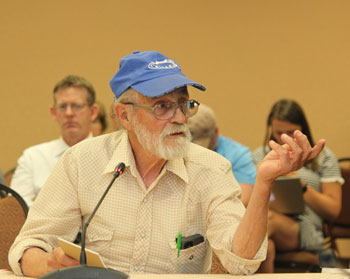
Don Sproul, tuna fisherman, Bath, ME “You can’t take everything out of the ocean and expect to get anything back.” Fishermen’s Voice photo
Tuna fisherman Don Sproul of Bath said he supported the 50-mile buffer. “There are too many small boats going out of business because we don’t get our bait that we used to,” he said. “All of our little day trawlers in mid-Maine are almost completely gone….There’s a place for the pair trawlers, but the guys with the little 24-foot, 30-foot boats, fishing next to these 200-and-some-foot boats, they don’t make it.” He added, “You can’t take everything out of the ocean and expect to get anything back….There’s a place for everybody, but it’s not all bunched up together.”
But, one fisherman responded, “It’s on an on about bashing trawlers. It’s rumor and untruths, over and over again.”
Lapp said her group didn’t support any of the buffer zones, particularly in Area 2 where the herring stock is transient. “Since none of the herring buffer zone alternatives were developed using any science, I can’t support it,” she said.
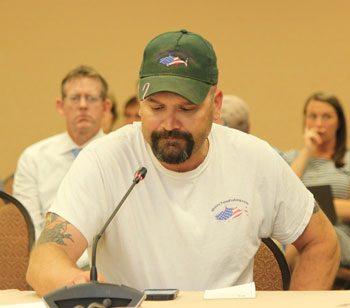
Shawn Tibbetts, charter tuna fisherman, Saco, ME. “We see it: Jeffrey’s is a dead zone. Georges is a dead zone.” Fishermen’s Voice photo
Shawn Tibbetts, who runs a charter fishing business out of Saco, said he supported Alternative 3, to extend the Area 1A prohibition of midwater trawl gear year-round, and Alternative 6, the 50-nautical-mile prohibition of midwater gear. “My business depends on these fish,” he said. “We see it: Jeffrey’s is a dead zone. Georges is a dead zone. There’s no baitfish….Localized depletion needs to be addressed.”
But Gehan said that all of the localized depletion alternatives would simply raise costs at a time when the ABCs will be cut. “Just in terms of the new assessment overtaking events, it’s going to leave a lot of conflict,” he said. “But any type of buffer zone will only increase costs. We’ll be catching less fish and spending more to do it.” Herring are important forage, he said. “But they’re not the only forage….There are a lot of forage fish out there. Fish eat a lot of different fish. Predators are generalists.” Gehan asked NEFMC to consider the cumulative socioeconomic impacts of fishery regulations. “One of the reasons the fishery fell so far short of meeting its overall ABC last year is simply the preponderance of rules” like 100 percent observer coverage in groundfish closed areas and shad and river herring catch caps. “All these things add up. And now we’re talking about adding even more,” he seaid.
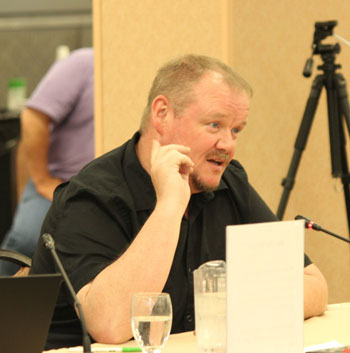
Gerry O’Neill, midwater trawler fisherman, Cape Seafoods, Gloucester, MA. “We lost flexibility when the spawning closures changed.” Fishermen’s Voice photo
Gerry O’Neill of Cape Seafoods in Gloucester, Mass., said increased restrictions on where the boats can go could potentially result in more bycatch. “We won’t be able to just move on somewhere else to try to catch fish,” he said. “We lost that flexibility when we lost access in 1A. We lost flexibility with the seasonal closure in 1B. We lost flexibility when the spawning closures changed. And we were forced to go where we didn’t particularly want to go, because of gear conflicts and everything else. So we’ve lost a lot of flexibility in the fishery and the ability to move around. If you’re interacting with bycatch, that ability to move around is very important, and we’ve lost that. And these buffer zones are going to just create more of that.” However, he said, he’s be open o to Alternative 9: Especially with the quotas expected to decrease, “if 1B were opened back up again, at least we’d get a mackerel fishery, somewhere closer to home during the winter months, which right now we can’t,” he said.
According to the draft amendment, the herring fishery is a primarily managed under a stock-wide annual catch limit (ACL) that is allocated among four management areas. Two areas are in the Gulf of Maine (Areas 1A and 1B). Area 2 includes southern New England and the Mid-Atlantic. Area 3 is the Georges Bank area.
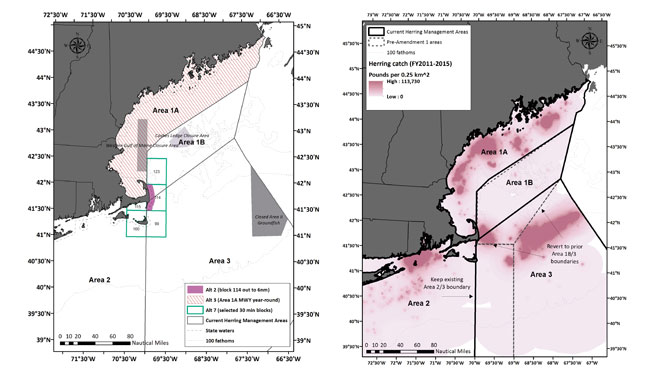
• Alternative 3 – year-round prohibition on using midwater trawl gear in Atlantic Herring Management Area 1A
(red hatching);
• Alternative 2 – closure to all vessels and gear types fishing for Atlantic herring within 6 nautical miles (nm) from shore in Area 114 (solid pink area off the back of Cape Cod) with a two-year sunset clause and two seasonal sub-options; and
• Alternative 7 – prohibition on midwater trawl gear within five different thirty minute squares with spatial and seasonal
sub-options (green outlined blocks).
• Alternative 8 – revert the Area 1B/3 boundary to pre- Amendment 1 coordinates (dashed lines above) but maintain the Area 2/3 boundary as it stands today, which would substantially expand Area 1B and commensurately reduce Area 3 to encompass less inshore water (note: herring catches shown in pink; darker patches indicate areas with higher catches); and
• Alternative 9 – remove the seasonal closure in Area 1B so that the area opens on January 1 instead of May 1, as is currently the case. NEMFC graphics.
In recent years, about 30 percent of total catch has been allocated to Area 1A and 1B combined, about 30 percent to Area 2, and about 40 percent to Area 3. There are many other measures in place that restrict herring catch and reduce bycatch.
Herring is used primarily as bait for the lobster and tuna fisheries but is also frozen whole and canned for human consumption. Landings have been variable in the last decade, averaging about 90,000 mt, with the highest amount in 2009 (about 104,000 mt) and lowest in 2016 (about 65,000 mt).
The fishery uses predominantly single and paired midwater trawl, bottom trawl, purse seine, and to a lesser extent, gillnet gear. Most landings are by midwater trawl gear (about 70 percent), followed by purse seine gear used exclusively in the Gulf of Maine (about 25 percent), and from bottom trawl gear (5-10 percent).
The average dockside price has increased over the last decade, from $238 per mt in 2007 to $426 per mt in 2016. Total revenues for the fishery have been above $20 million dollars per year for some time, peaking above $30 million in 2013.
Atlantic herring play an important role as forage. They are eaten by a wide variety of fish, marine mammals, birds, and humans. Many other species – like sandlance, mackerels, squids, and hakes – serve as forage. But herring are distinguished by a high-energy caloric content.
“In the short-term, the relatively poor recruitments in 2013-2017 will increase the vulnerability of the stock to becoming overfished,” the draft amendment says.
NEFMC is expected to take final action on Amendment 8 at its late-September meeting in Plymouth, Mass. Potential implementation is in May 2019.
In its discussion of specifications for the 2019-2021 fishing years, and without yet knowing how much the overall quota would be decreased, aimed to lessen the impact of reductions in 2019 in its proposals to:
• Cap the 2018 harvest of Atlantic herring at 2017 catch levels in Management Areas 1A, 1B, and 3; and
• Set the Area 2 sub-annual catch limit (sub-ACL) at 8,200 metric tons (mt) for 2018.
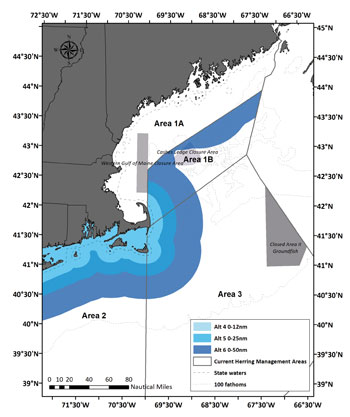
ABC (Acceptable Biological Catch) control rules define how catch or fishing mortality change with stock size. They are used in setting annual catch limits. Color coded above are Buffer Zone Alternatives 4, 5, and 6, which could be applied year-round or seasonally, where midwater trawl gear would be prohibitied insde 12 nautical mile (nm), 25 nm, or 50 nm zones in Herring Management Areas 1B, 2, and 3 from Cape Cod to the North/South Carolina border. NEMFC graphic. Fishermen’s Voice photo
The 2018 ACL for Atlantic herring is 111,000 mt, which is what it was in 2017. The fleet only harvested roughly 50,000 mt of the ACL in 2017. NEFMC said that by “freezing the footprint” at 2017 catch levels and capping catches at approximately 50,000 mt in 2018, reductions in 2019 would not be as severe as if the fleet harvested the full 111,000 mt ACL.
According to the release, NEFMC’s 2019-2021 specifications package will be implemented on Jan. 1, 2019, which is the start of the next fishing year for Atlantic herring. Under current regulations, the 2018 specifications will roll over on Jan. 1 and remain in place until NMFS implements a final rule. NEFMC expressed concern about the potential impacts of having the 2018 ACL of 111,000 mt roll over to start off the 2019 fishing year because, if the final specifications package contains a much lower ACL, the fishery could come to a quick end if harvest levels at the time of the final rule’s implementation are close to or exceed the new ACL. But if the catches in Areas 1A, 1B, and 3 are capped at 2017 levels, then the adjusted 2018 ACL of roughly 50,000 mt will roll over on Jan. 1 and help smooth out the severity of the expected economic impacts in 2019.
NEFMC didn’t suggest capping 2018 Area 2 landings at 2017 catch levels because 2018 catches from Area 2 to date already have exceeded the amount caught in 2017. January-May 2018 catches are just short of 7,000 mt, while 2017 Area 2 catches totaled less than 4,000 mt. Therefore, freezing catch at 2017 levels is not possible for Area 2.
Instead, NEFMC recommended that NMFS consider using the current catch estimates from 2018 for Area 2 and adding additional quota to account for some level of access for: • Small-mesh bottom trawl vessels that typically do not fish in Area 2 until later in the season, often not until November and December; and
• Incidental catches that may continue to come in during the remainder of the year.
Tooley said she supported the motion to smooth the transition. “Clearly it’s a very difficult situation,” she said. “Doing this will not make next year easy by any mean, but at least it’s a little bit of help.”
A NEFMC member said the motion was workable. “To have zero fish – these are small day boats – to be shut out of that fishery unexpectedly is a shock nobody’s going to appreciate,” he said. “If we can carve off a few tons for Area 2 through the end of the year, we can make that work. We’re going to be in trouble next year; everyone knows that. But I don’t think Area 2 deserves to be put out of the fishery this year.”
